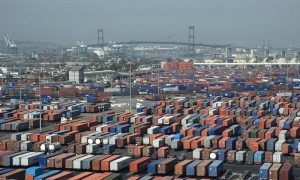PRESS RELEASE
Decades Long Battle Spotlights Port’s Violations of Law, Harm to Community
LOS ANGELES (September 16, 2020) – Charging the City of Los Angeles with failure to follow state environmental law, community and environmental groups including the Coalition for Clean Air filed suit in Superior Court to void the City Council’s recent certification of the Port of Los Angeles’ 2019 Supplemental Impact Report (2019 SEIR) for the China Shipping Container terminal.
The 2019 SEIR allows the Port and its tenant, China Shipping, to continue profiting from the terminal, while scaling back clean air measures the Port adopted in 2008 to clean up toxic emissions that contribute to the diesel death zone surrounding the Port.
NRDC (Natural Resources Defense Council) and its coalition partners have demanded for more than20 years that the Port stop externalizing the cost of the terminal’s continued operation on the community, which pays for it in chronic illness, lost wages, sickness, and death. Most of the mitigation measures abandoned by the Port involve diesel-powered trucks, ships, and yard equipment used at the terminal.
Following are statements from groups involved in the suit:
“Even when they comply with the law, the Port of Los Angeles causes too much air pollution,” said Dr. Joseph Lyou, President and Chief Executive Officer of the Coalition for Clean Air (CCA). “The China Shipping fiasco makes matters worse. The Port’s failure to abide by the law results in people breathing more toxic diesel exhaust and more smog. It’s a tragedy, yet they show no remorse and go on polluting.”
“The Port of L.A. broke the law by abandoning its clean air commitments in the original EIR and, without justification, adopting measures that are far less protective” said Melissa Lin Perrella, Senior Director of Environmental Justice at NRDC. “The Port hid its actions from the public for nearly a decade, resulting in communities shouldering more and more pollution. The Port is not above the law. Our lawsuit seeks to hold the Port accountable.”
“Community members have long suffered the effects of air pollution in their own back yards,” said Taylor Thomas, Co-Director of East Yard Communities for Environmental Justice. “The Port of L.A. must put people over profit and loyally protect the health of local residents. They’ve failed to do that. We will continue fighting so residents can freely step outside without the threat of reducing years from their lives for every breath they take.”
“The Port has shamelessly violated environmental protections it committed to more than a decade ago,” said Dr. John G. Miller of the San Pedro and Peninsula Homeowners Coalition (SPPHC). “Residents of San Pedro, Wilmington, and Long Beach face higher cancer risks, asthma rates, cardiovascular mortality rates, and a higher risk of death from COVID-19 in the diesel death zone that surrounds the Port. We refuse to keep suffering with the consequences of pollution from the Port. Today’s lawsuit is yet another chapter in our fight for justice.”
“The Port legally promised it would adopt health-protective measures to minimize toxic air pollution from ships, trucks, and equipment at the China Shipping terminal,” said Janet Schaaf-Gunter of the San Pedro Peninsula Homeowners United (SPPHU). “Instead, Port authorities slithered around behind closed doors, abandoning many of its original environmental commitments, which resulted in unfathomable health consequences for residents and dockworkers living and working in this diesel death zone around the Port. We demand better air for our families and our communities.”
Background
Almost 20 years ago, the Port of Los Angeles signed a forty-year lease with China Shipping to expand and operate a large container shipping terminal, but the Port failed to prepare a project-specific environmental impact review and adopt mitigation measures to offset the environmental impacts of the project, as required by the California Environmental Quality Act (CEQA). NRDC, CCA, SPPHC, and SPPHU then successfully sued the Port to stop the project until it met CEQA compliance and negotiated measures to reduce the environmental impacts of the terminal.
In 2008 the Port issued an Environmental Impact Report that analyzed the environmental impacts of the China Shipping terminal and adopted a number of measures to reduce air pollution. But the Port failed to implement about a dozen of those commitments. And, by 2015, it became clear that the Port had for years granted secret waivers to China Shipping, allowing the terminal to operate in violation of one of the major environmental commitments in the 2008 EIR. In 2019, the Port presented a new Supplemental EIR, which—rather than remedying its past failures – eliminated or modified the original mitigation measures.
The Port of Los Angeles handles more than 40 percent of all containerized cargo in the West Coast, and at least 17 percent of all containerized cargo nationwide. Diesel particulate matter from ships, trucks, trains and diesel-powered equipment at the Port, is a carcinogen, and exposure to dangerous air pollutants such as smog and nitrogen oxide cause and exacerbate respiratory diseases. Neighboring residents are heavily impacted by these emissions and communities face the region’s highest cancer risk from air pollution and suffer from some of the highest asthma rates across the state.
Coalition for Clean Air, NRDC, San Pedro and Peninsula Homeowners Coalition, San Pedro Peninsula Homeowners United, and East Yard Communities for Environmental Justice, are the named plaintiffs in the case.
###








